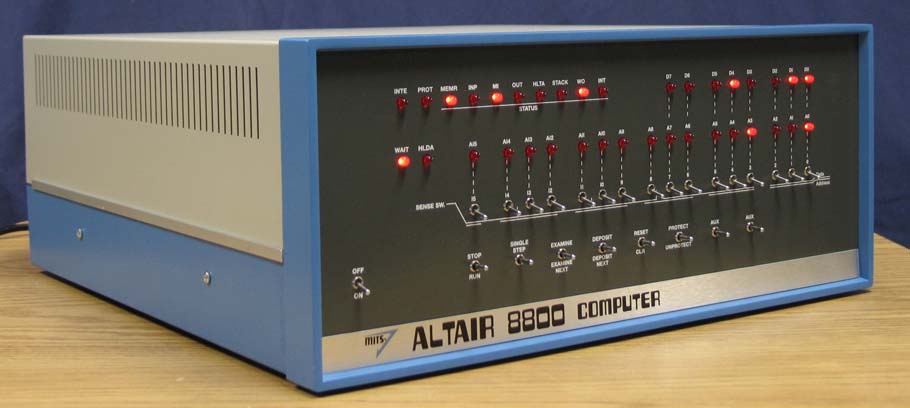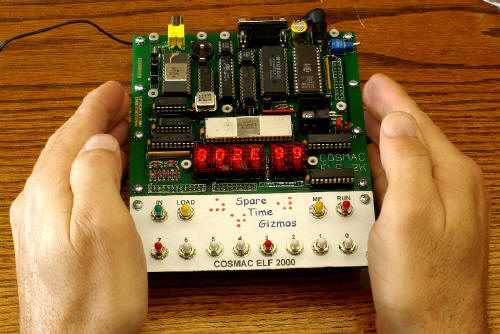Altair: Everything Old is New Again

When I was barely a teenager, Popular Electronics ran their famous "Altair" article. I had just started learning about computers and I was mesmerized. The idea that you might be able to buy a computer and have it in your home just boggled my mind. I don't know what I thought I'd do with it, but I wanted one.
The problem was they were about $400 and even that was with little or no memory and certainly not with a terminal or other interface. In those days, $400 might as well have been a million to me. So I drooled over the Altair catalog (which I still have) and read every Popular Electronics article.
I'd eventually go on to build an 1802 (and I've written about that before). But I've always wanted an Altair.
I guess I'm not the only one. Someone is now producing pretty
authentic Altair kits. The PCBs are a little more modern, but the ICs are original period ICs. So far, the only ones available are on eBay, but the Web site promises to actually sell them soon. Pricing is "probably" less than $1700. Hmm... I still can't afford an Altair. I wonder what my wife would tell me if I spent $1700 on "another computer" -- and one that doesn't do anything she'd appreciate at that!
But I know how hard it is to put a kit on the market, and that's a big kit with hard to find parts. So I don't blame the vendor for the price tag. If I were single (or if I wanted to be single again), I'd buy one in a flash.
Labels: old computer
Submit to:
 Del.icio.us |
Del.icio.us |
 Digg |
Digg |
 Slashdot |
Slashdot |
 Diigo
Diigo
New US Ham Band Allocations Coming Soon
If you don't keep up with the Ham Radio news, maybe you haven't heard that the FCC has reallocated the US Ham bands. The changes go into place on 15 December 2006.
The ARRL has a
band plan chart.
What are the changes? On 80 meters the top end of the CW/RTTY/Digital band now will be at 3600 kHz. Phone will now begin at 3600 kHz for Extras; and 3700 kHz for Advanced. The General phone band will start at 3800 kHz.
On 40 meters, the Extra/Advanced phone band will start where the CW band ends: 7125 kHz. The General phone band will start at 7175 kHz.
On 15 meters, the bottom of the General phone band will be at 21275 KHz. The bottom of the phone band for Extra and Advanced will remain unchanged.
On 10 meters, Novices and Technicians with CW credit will now be able to use CW/RTTY/Digital from 28000 kHz to 28300 kHz. Their voice band (28300 kHz to 28500 kHz) remains unchanged.
In addition, for Novices and Technicians with CW credit, there are now privileges for CW use only on the same frequencies as General and Advanced licensees on 80, 40, and 15 meters: 3525 kHz to 3600 kHz; 7025 kHz to 7125 kHz; and 21025 kHz to 21200 kHz.
My favorite band, 20 meters, remains unchanged.
Labels: Ham
Submit to:
 Del.icio.us |
Del.icio.us |
 Digg |
Digg |
 Slashdot |
Slashdot |
 Diigo
Diigo
History: PDP-1
Many of us used the old DEC PDP-series of computers. You could easily argue that these computers blazed the trail for the idea that a computer could "belong" to someone who would use it themselves and not be shared across a company with an army of acolytes to feed and service it.
But not many of us worked on the first PDP computers (I certainly didn't) and it is interesting to see how far those little computers came over the years.
The Computer History Museum has a great online exhibit:
http://www.computerhistory.org/pdp-1/index.phpOf course, with an FPGA you can build your own PDP computer:
http://www.aracnet.com/~healyzh/pdp_fpga.htmlThe PDP-8, maybe the most important member of the PDP family originally had 8 instructions! You can run a real one (not a simulation) at:
http://www.pdp8.net/run.shtmlLabels: old computer
Submit to:
 Del.icio.us |
Del.icio.us |
 Digg |
Digg |
 Slashdot |
Slashdot |
 Diigo
Diigo
Windows Gets the Emacs Religion
You know, for some of us Emacs isn't a program -- its the guiding force in life (well, maybe I'm going a little overboard... then again,
maybe not).
The problem with getting those Emacs commands ingrained in your head (or your fingers) is that you then have to use other programs! It is very painful to use Word or an IDE without those Emacs keystrokes.
I'm writing this on a Windows box using Firefox in a Blogger HTML editor. But guess what? Control+A takes me to the start of the line, Control+W cuts, and Control+Y pastes! Why? I'm running xkeymacs, a nice free program that lets you map Emacs keystrokes for Windows applications.
It does take a little work to get everything just right. For example, I added ^X-0 (zero) to send Firefox a Control+W which closes the current tab. ^X-2 can create a new tab. It is a little tricky to add new things (but not too bad, you just have to edit a text file with a lisp-like syntax). You also need to set it up so each program has its own settings (which means you can disable it for certain programs, or change Control+W to send escape (for Thunderbird, for example).
You can find xkeymacs here:
http://www.cam.hi-ho.ne.jp/oishi/indexen.html If you prefer just "fixing" Office applications, you might try:
http://www.rath.ca/Misc/VBacs/Oh, and if you don't think Emacs is powerful enough, here's some food for thought:
http://www.informatimago.com/linux/emacs-on-user-mode-linux.htmlLabels: emacs, software, windows
Submit to:
 Del.icio.us |
Del.icio.us |
 Digg |
Digg |
 Slashdot |
Slashdot |
 Diigo
Diigo
Free OCR Tool
When HP exited the optical character recognition business in 1995, its Tesseract OCR engine was released to UNLV as open source. In January, developers (including some from Google) decided Tesseract was stable enough to "re-release" as an open source project.
Don't expect too much. You'll need to compile the source code (if you use Cygwin, be prepared to copy /usr/include/limits.h to /usr/include/linux/limits.h or fix the source). And then you get a command line tool that reads single-column TIFF files from the command line. But the accuracy is much better than most of the cheap OCR tools out there.
Try it here.Labels: software
Submit to:
 Del.icio.us |
Del.icio.us |
 Digg |
Digg |
 Slashdot |
Slashdot |
 Diigo
Diigo
HACK: Cheap RF Remote
I just posted an article about how I took a $10 Radio Shack wireless doorbell and turned it into a PowerPoint "clicker" for my PC. Includes the software, so
check it out.
Labels: article, electronics, hack
Submit to:
 Del.icio.us |
Del.icio.us |
 Digg |
Digg |
 Slashdot |
Slashdot |
 Diigo
Diigo
Cool Service: Record from your cell phone to the net!
Check out
this free service. Call a toll-free number, leave a message, and it shows up on the Internet and/or your e-mail. Looks good for quick notes to yourself or maybe even "live" clips for podcasting. Oh, it recognizes who you are by your phone number (in case you were wondering).
Labels: cool, webapp
Submit to:
 Del.icio.us |
Del.icio.us |
 Digg |
Digg |
 Slashdot |
Slashdot |
 Diigo
Diigo
Jericho Morse Code Message (8 Nov)
One advantage to being a ham radio operator is you can read the badly sent Morse Code at the start of each episode of Jericho. I will warn you though, this is a spoiler that was not revealed by the episode. The message read: Rob not FBI. Hmmmm......
Submit to:
 Del.icio.us |
Del.icio.us |
 Digg |
Digg |
 Slashdot |
Slashdot |
 Diigo
Diigo
RCA COSMAC ELF 1802 Articles

When I was in high school I built an 1802-based ELF, which I had a lot of fun with. It languished in a shed I had in south Mississippi. Every time we'd visit, I'd promise to go find the ELF and get it working again. Then last year Katrina struck and wiped out my little shed.
I did find the poor little computer, but it was seriously destroyed. Luckily, I found
Spare Time Gizmos selling a kit and I bought it. Honestly, I thought I didn't have time to build it so I'd put it on the shelf until I did. But dog gone it, once it came it I had to put it together right away. It's a great kit.
There's actually a thriving community of 1802 people on the Web. Mike Riley has his RCASM assembler, and there's a lot of other software floating around. To do my bit, I put three new articles in the
Articles section. One covers how to change RCASM to recognize erroneous short branches. The second shows how to use minicom under Linux to download to the board. The third article is a link to my 1802 disassembler software I wrote.
Oddly enough, the first articles I ever wrote were for a little "magazine" called QuestData that was published by Quest who made an ELF clone in those days. I'd have never dreamed I'd go on to write for Dr. Dobb's Journal, Web Techniques, and a host of other "real" magazines. Of course, those first articles were terrible -- pains me to read them now -- but you have to start somewhere!
Labels: 1802, article, old computer
Submit to:
 Del.icio.us |
Del.icio.us |
 Digg |
Digg |
 Slashdot |
Slashdot |
 Diigo
Diigo
 When I was barely a teenager, Popular Electronics ran their famous "Altair" article. I had just started learning about computers and I was mesmerized. The idea that you might be able to buy a computer and have it in your home just boggled my mind. I don't know what I thought I'd do with it, but I wanted one.
When I was barely a teenager, Popular Electronics ran their famous "Altair" article. I had just started learning about computers and I was mesmerized. The idea that you might be able to buy a computer and have it in your home just boggled my mind. I don't know what I thought I'd do with it, but I wanted one. Del.icio.us |
Del.icio.us |
 Digg |
Digg |
Slashdot |
 Diigo
Diigo


 RSS Feed
RSS Feed